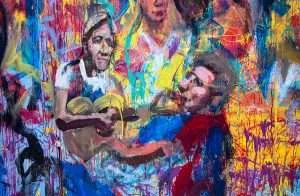Coffee is my all-time favorite beverage. While my family typically zeroes in on Indian chai, we can hardly resist a cup of freshly brewed Madras filter coffee from our neighborhood cafe. Apart from the physiological caffeine rush that both tea and coffee provided, these are social beverages that never fail to ease up a conversation or create a memory. In this regard, from Starbucks to Vidyarthi Bhavan, cafes are an invaluable site to the coffee drinking experience. In other words, we can compare India’s cafe culture to the sociological concept of a third place.
The Cafe as a Third Place
There’s more to cafes than steaming hot black coffee without sugar. In his book, The Great Good Place, published in 1998, the American sociologist Ray Oldenburg refers to coffee shops as a ‘third place’ outside the realms of work and home that serve as a neutral location to all. He also points out that cafes hold an enormous social and historical value that often go unreported, particularly in academia—consider American taverns, French cafes, Greek Agoras, and London’s coffee houses, all of which were sites of revolutions, gatherings or movements. However, a number of these “forgotten” cafes carry on their legacy in unnoticed ways. For instance, what eventually became the New York stock was founded at the Tontine coffee house in 1792, and the American cocktail Sazareck, was named after a coffee shop of the same name in New Orleans in 1850.
While Oldenburg’s ‘third place’ framework helps articulate the function of cafes with respect to their surrounding sites, there is no one homogeneous model followed by cafes across the world—or even in the same country or city, for that matter. This can be illustrated by comparing two types of eateries on opposite ends of the spectrum—Starbucks, an American-origin multinational coffee chain, and Vidyarthi Bhavan, an icon heritage site of old Bangalore in India.
The Starbucks Aesthetic
Starbucks prides itself on humble beginnings. What began as a small cafe in Seattle’s Pike Place Market by three friends from the University of San Francisco in 1971 steadily grew by expanding outlets in Chicago and Vancouver (1987), Japan and Singapore (1996) and the UK, New Zealand, and select South East Asian countries (1998).
From Boston to Bangkok, you’ll find an identical look and feel to every Starbucks outlet – complete with polished wooden tables, a roasted coffee bean decor on one of the walls, high schoolers on their laptops, an old man reading the papers, and/or an office-going woman sipping her latte. Starbucks captures this western ‘ideal’ of the coffee drinking experience –inspired from Europe’s corner espresso bars – creating a template common to other cafes and pop culture representations of the ‘industrialized west’ or global north as well.
Starbucks in India
Can the Starbucks model simply be replicated across cultures and contexts? Possibly so, and it’s already happening – given certain limitations. India’s Tata Starbucks Alliance thrives on a hyper-specific clientele of urban-residing, wealthy, upper-class youth to keep its business thriving.
The Economics of Starbucks
One of the biggest factors rendering Starbucks one of India’s most elite coffee chains is its economics. Starbucks orders in the USA range from 2-6 USD on average, making it a student-friendly, on-the-go option for local students and workers. Matching up to these prices, India’s Starbucks outlets offer goods priced between 190 – 275 INR, wrestling with a sea of cheaper and more familiar options from neighboring coffee chains. In a country employing roughly 80% of its labour force in the informal sector, where 75% of citizens live in rural or remote areas (with the main earning member earning less than 5,000 INR per month), Starbucks outlets are spaces accessible to only the very upper-crust layer of Indians.
The Cultural Aesthetics of Starbucks
Cafes of the west aren’t too different from offices or libraries. You’re likely to find customers typing away on their laptops, sipping on cappuccinos, getting work done. However, eateries in India have for long been associated with leisure and recreation. In fact, one of Cafe Coffee Day’s earliest TV commercials emphasizes ‘sitting down’, also synonymous to ‘chilling’. This singalong advertisement makes a larger statement on this 18-25 year old demographic group. Although, they come here with their friends or peers quite like their western counterparts, Indian students are more likely to place their order for mug of coffee and a snack as a social activity – and not to boost productivity or kick-start their day.
As discussed above, these coffee spaces have gained immense popularity among the country’s urban residing, the ‘uppermost crust’ of Indian youth in particular. Despite the heavy price (or perhaps, because of it), students and young working professionals flock in groups to emulate the western coffee-drinking aesthetic. However, the function of these cafes has nevertheless been different – they still come here on dates or to celebrate birthdays with friends, not to study for a test.
In essence, while Starbucks outlets around the globe offer an identical look and feel to its customers, it is unrealistic to imagine the western ‘workaholic’ aesthetic of coffee drinking can be simply imported to India, and by extension, other countries of the global south. There are a legacy of differences in how spaces are used and interpreted, which are to be considered in the coffee drinking experience.
The Vidyarthi Bhavan Aesthetic
On the opposite of the spectrum to Starbucks is Vidyarthi Bhavan, an iconic traditional restaurant in Bangalore. Established in the year 1943 to serve students of two nearby institutions, this eatery prides itself on affordability, local flavors, and non-nonsense service. Families and old uncles come here to chit-chat over a cup of steaming coffee or masala dosa. When I visited the restaurant myself in 2017, business was brisk, chaotic, and yet somehow organized – service staff breezed by tables balancing six decked up plates in an arm, dishing out orders, and making new ones. You’ll find just five items on the menu, chalked up on a blackboard on the wall, all ranging from 10 – 50 INR (that’s $0.13 – $0.66 USD). The coffee here was priced at a mere 16 INR (0.21 USD) – that’s roughly one-seventh the price of a small cappuccino from a Starbucks India outlet. This ‘mini tiffin’ or ‘sit, grab and go’ culture forms the hallmark of old Bangalore, and by extension, a number of similar middle-to-low priced traditional cafes and restaurants in India.
The Diversity of Coffee Drinking Experiences
As the world’s Dunkin Donuts and Costa Coffee outlets multiply, the western aesthetic of coffee drinking has not just been introduced but also gained steady popularity. From getting your name scribbled on the cup to broadcasting your order on Instagram, India’s urban-class youth has been quick to embrace western-oriented capitalist behaviors of coffee drinking. However, much like the customers at Vidyarthi Bhavan, they would rather come here for a gossip session than to finish an assignment.
There is no standard coffee drinking experience. And perhaps it’s these choices of how, when, where, and with whom to consume coffee, that contributes to the magic of the coffee drinking experience, wherever you are.






